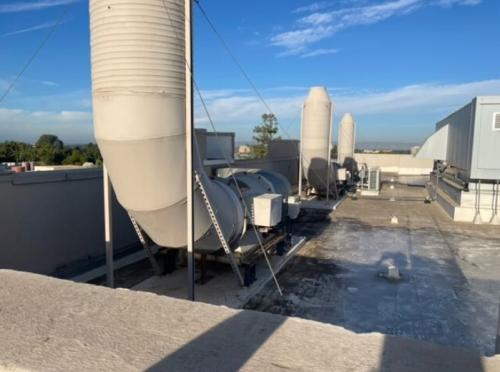Enhancing Campus Sustainability
A Look at the Physics Building Project

As we walk around campus, we often overlook the intricate systems that silently work behind the scenes. Today, we take a closer look into a significant project that plays a pivotal role in both our research efforts and the sustainability of our campus: the renovation of the exhaust fans in the Physics building. We had the opportunity to chat with the team driving this initiative.
The work began as part of long-overdue maintenance planning and prioritization project. The six exhaust fans in the building, three on the west and three on the east high roof had been in service for over four decades and had exceeded their expected lifespan. As Ralph Fickett, the Mechanical HVAC Superintendent, aptly puts it, "This project is the definition of deferred maintenance."
We asked Ralph why this project was so crucial, and he explained that not only had these units outlived their expected lifespan, but the upgrade would also lead to energy savings. It also allowed us to reduce the total number of exhaust fans from six to four, simplifying future maintenance. This reduction in fan count means less disruption for building occupants and researchers due to frequent repairs on the old systems.
To make this project a reality, a mechanical engineering consultant was brought in by Ralph to create a plan that would offer backup in case of fan failure. This engineering feat is what resulted in the reduction of exhaust fans. The project commenced on April 5, 2022, and is divided into four phases, with the final phase slated for completion in 2024.
A diverse group of skilled professionals contributed to the project, including Mechanical HVAC IPE Nathan Wilkinson, Mechanical HVAC Supervisor Albert Bacchini, Sheetmetal Shop Mechanics, Machinists, Mechanical HVAC Ventilation Supervisor Ben Griffin, and Ventilation Mechanics.
For those less familiar with the facilities, the primary goal of the project is to ensure fan redundancy. In simple terms, these new exhaust fans will step in during maintenance on other existing fans, ensuring uninterrupted operation of the system.
A fascinating aspect of this project was the safety wind tunnel study that was conducted. This study provided valuable insights into efficiently moving air under different wind conditions, leading to modifications in the ductwork layout.
While there are no immediate follow-up actions for this project, it remains a crucial element of our campus infrastructure that will serve its purpose for many years. The state-of-the-art exhaust fans now have an expected lifespan of approximately 30 years.
Though the Physics building exhaust fan project may go unnoticed by many, its impact on our research activities and campus sustainability is profound. We commend the dedicated team behind this project for their commitment to enhancing our campus infrastructure and reducing energy consumption. This endeavor underscores our dedication to maintaining a secure, efficient, and sustainable campus environment.